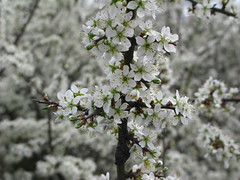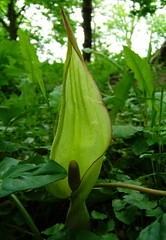I took a long walk yesterday in an area we normally visit infrequently, and then usually by car. It is amazing how much more that you notice when you are on foot. I began below the village, exploring a trackway which on the map looped round to the next road across.. In the corner of a field, where the trackway turned right, I was surprised to find ruins with a drift of snowdrops sprinkled over them, and several well-established yew trees keeping all in shadow. Yew trees are usually only associated with churchyards hereabouts, but as I walked along the trackway, I noticed more young yew trees planted in the hedgerows. This is unusual as Yew is deadly to livestock and this is a farming area. These mixed plantings had been double fenced to keep livestock off. I climbed the hill out of the village and past the Big House, with its long driveway, and all around the perimeter were more young yew trees, planted with others, and double fenced. It was easy to see where the land of the Big House ended.
In the hedgerows were the first signs of spring - Celendines with their beautiful lemon-yellow flowers, which open with the day. They have tiny heart-shaped leaves and in country areas, are harbingers of spring, arriving when the Primroses do. In previous years they have been earlier than this, but the cold snap in January and the snow earlier this month, has got spring back on a more even keel again.

There has been a dearth of Sloes on the Blackthorn in recent warm springs, which suggests they may have been encouraged to bloom too early and got caught by late frosts. There is an old saying that when the Blackthorn is in bloom, it is a Blackthorn Winter. This stems from there often being a warmer period at the end of winter - a false spring - and then a sudden cold snap returns. Here is a photo of the blossom, courtesy of Creative Commons.

The Sloe fruit is like a small black plum (it is a wild member of the Prunus - Plum - family) with a blue bloom on it. It is VERY sour, but makes wonderful jam and even better Sloe Gin! Its hedgerow relative the Bullace, is slightly larger and thought to be a cross between Sloe and domesticated plums.

This 'witch's broom' is caused by a viral infection attacking the tree and causing a mass of twiggy growth.

The fruit of the Ivy. The leaves in the background are rather shapeless, unlike those three-cornered ones in the picture of the mossy bank below, which is how ivy normally grows. Likewise, holly leaves tend to lose their prickles when they are higher up in the tree and presumably because they are under less threat from predators!

These are the leaves of the Ribwort Plantain which is very common in grassy places - banks, hedgerows and fields alike. When we were children we would 'fight' with the flower heads of these, which are brown cylinders on the end of the stalk, and by running your hand briskly up the stem you could catapult the head at your 'enemy'.

Ivy leaves, top left, climbing over a mossy bank. Here in Wales there is no shortage of rainfall, and in consequence, plenty of mosses!

Here are the young leaves of Lords and Ladies, or Cuckoo Pint as they are also known. Their 'proper' name is the Wild Arum Lily. When in flower they look like this:

Here is Navelwort, so called becuse of the dimple in the middle of the leaf. They will grow on banks, treestumps and dead branches (as here), and on walls. My children used to pick the leaves and use them for doll's teaparties. Their leaves are prolific in winter, then they flower and put out a creamy stem of flowers (which I shall photograph when they bloom locally) and then they die back in the summer months.

Now today (Friday) since clearing the shallow shelf of my wildlife pond, the first frogspawn has been laid. Photographs tomorrow.













